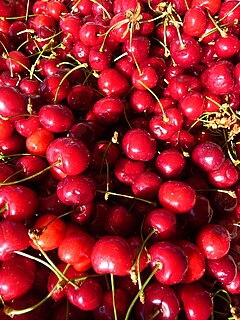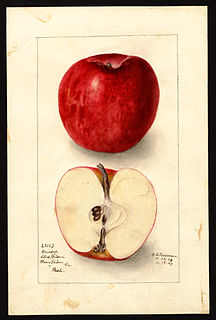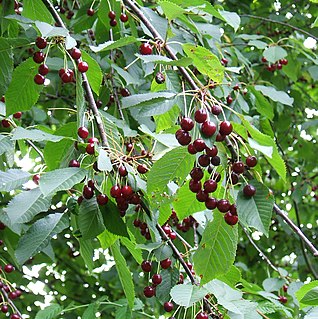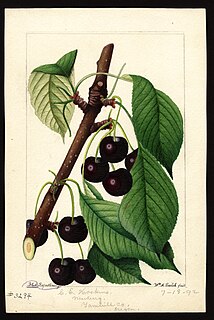
A cherry is the fruit of many plants of the genus Prunus, and is a fleshy drupe.

A plum is a fruit of some species in Prunus subg. Prunus. Mature plum fruits may have a dusty-white waxy coating that gives them a glaucous appearance. This is an epicuticular wax coating and is known as "wax bloom". Dried plums are called prunes, which have a dark, wrinkled appearance.

Prunus cerasus is a species of Prunus in the subgenus Cerasus (cherries), native to much of Europe and southwest Asia. It is closely related to the sweet cherry, but has a fruit that is more acidic. Its sour pulp is edible.

A cherry blossom is a flower of many trees of genus Prunus or Prunus subg. Cerasus. They are also known as Japanese cherry and Sakura. They generally refer to ornamental cherry trees, not to cherry trees that produce fruit for eating. It is considered the national flower of Japan.

Hanami is the Japanese traditional custom of enjoying the transient beauty of flowers; flowers (hana) in this case almost always refer to those of the cherry (sakura) or, less frequently, plum (ume) trees. From the end of March to early May, cherry trees bloom all over Japan, and around the first of February on the island of Okinawa. The blossom forecast "cherry blossom front" is announced each year by the Japan Meteorological Agency, and is watched carefully by those planning hanami as the blossoms only last a week or two.

The damson or damson plum, also archaically called the "damascene", is an edible drupaceous fruit, a subspecies of the plum tree. Varieties of insititia are found across Europe, but the name damson is derived from and most commonly applied to forms that are native to Great Britain. Damsons are relatively small ovoid plum-like fruit with a distinctive, somewhat astringent taste, and are widely used for culinary purposes, particularly in fruit preserves and jams.

Prunus cerasifera is a species of plum known by the common names cherry plum and myrobalan plum. It is native to Southeast Europe and Western Asia, and is naturalised in the British Isles and scattered locations in North America. Also naturalized in parts of SE Australia where it is considered to be a mildly invasive weed of bushland near urban centers.

Mirabelle plum, also known as mirabelle prune or cherry plum, is a cultivar group of plum trees of the genus Prunus. It is believed that the plum was cultivated from a wild fruit grown in Anatolia.

Prunus serrulata or Japanese cherry is a species of cherry tree that grows naturally in Japan, China, Korea and Russia, and it also refers to a cultivar produced from Prunus speciosa, a cherry tree endemic in Japan. Historically, the Japanese have developed many cultivars by selective breeding of cherry trees, which are produced by the complicated crossing of several wild species, and they are used for ornamental purposes all over the world. Of these, the cultivars produced by complex interspecific hybrids based on the Oshima cherry are also known as the Cerasus Sato-zakura Group.

Bing is a cultivar of the wild or sweet cherry that originated in the Pacific Northwest, in Milwaukie, Oregon, United States. The Bing remains a major cultivar in Oregon, Washington, California, Wisconsin and British Columbia. It is the most produced variety of sweet cherry in the United States.

Rainier is a cultivar of cherry. It was developed in 1952 at Washington State University by Harold Fogle, and named after Mount Rainier. It is a cross between the 'Bing' and 'Van' cultivars.

Winesap is an old apple cultivar of unknown origin, dating at least to American colonial times. Its apples are sweet with a tangy finish. They are used for eating, cooking, and cider.
Tartarian may be the adjective form of:

The Ulster cherry is a sweet cherry cultivar that originated in the United States.

Prunus avium, commonly called wild cherry, sweet cherry, gean, or bird cherry is a species of cherry, a flowering plant in the rose family, Rosaceae. It is native to Europe, Anatolia, Maghreb, and Western Asia, from the British Isles south to Morocco and Tunisia, north to the Trondheimsfjord region in Norway and east to the Caucasus and northern Iran, with a small isolated population in the western Himalaya. The species is widely cultivated in other regions and has become naturalized in North America and Australia.
The Santorini tomato 'τοματάκι Σαντορίνης' is a variety of cherry tomato from Santorini, Greece. Santorinis have a deep red color and have firm, not particularly moist flesh with a high seed content. They are known for their high carbohydrate content and a sweet, strongly acidic taste. They have a round, slightly flattened shape and weigh 15–27 grams. They often have pronounced flutes, especially those growing lowest on the plant. The fruits generally ripen in 80–90 days.

Stella is a cultivar of cherry developed in British Columbia, Canada. It is notable as the first self-fertile sweet cherry to be named. It has been awarded the Royal Horticultural Society's Award of Garden Merit.

The Black Republican cherry is a cultivar of cherry. While it is a hybrid, its parentage is not known; it is possibly a cross of the Napoleon and Black Tartarian cultivars, but has also been described as a seedling of the Eagle variety. One of the parents of the Bing cherry, the Black Republican was first grown in Oregon about 1860 by the horticulturist Seth Lewelling, who gave it its name as a reflection of his Abolitionist beliefs.
Van is a cultivar of cherry originating from Canada.
Skeena is a cultivar of cherry originating in Canada.

















